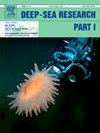Forecasting summer marine heatwaves in the South China Sea using explainable machine learning models
IF 2.1
3区 地球科学
Q2 OCEANOGRAPHY
Deep-Sea Research Part I-Oceanographic Research Papers
Pub Date : 2025-01-31
DOI:10.1016/j.dsr.2025.104457
引用次数: 0
Abstract
Marine Heatwaves (MHWs), classified as extreme oceanographic meteorological phenomena, have profound effects on ecological systems and socio-economic activities within the South China Sea (SCS). Multiple machine learning (ML) algorithms, specifically Random Forest (RF) and Ridge models, are employed to predict summer Sea Surface Temperature Anomalies (SSTA) and occurrence of MHWs in the SCS. The ML forecast results are also compared with climatology forecasts, persistence forecasts, and the European Centre for Medium-Range Weather Forecasts Sub-seasonal to Seasonal (ECMWF S2S) hindcasts. The results reveal that for regression forecasting with a one-week lead time, the Ridge model performs the best among all models. However, for longer lead times, all models tend towards climatology forecasts. When it comes to the classification forecasting, the RF model demonstrates superior performance to predict extreme MHWs compared to typical MHWs. Moreover, the feature importance is measured via the mean decrease in impurity (MDI) incorporated in the RF model to identify the predictors that contribute to predicting the MHWs. The SHapley Additive exPlanation (SHAP) algorithm is additionally employed to evaluate both the positive and negative impacts of these predictors on the model. SSTA and the Indian Ocean Basin-Wide (IOBW) index are the most two critical forecasting factors influencing the occurrence of MHWs, exhibiting a pronounced positive contribution to the model. The insights derived from this study are expected to provide strong support for the MHWs early warning system in the SCS and provide essential information for the conservation of marine ecosystems and the management of fisheries resources.
利用可解释的机器学习模型预测南海夏季海洋热浪
海洋热浪是一种极端海洋气象现象,对南海生态系统和社会经济活动有着深远的影响。采用多种机器学习(ML)算法,特别是随机森林(RF)和Ridge模型来预测夏季海面温度异常(SSTA)和南海mhw的发生。ML预报结果亦会与气候学预报、持续时间预报及欧洲中期天气预报中心分季至季预报(ECMWF S2S)进行比较。结果表明,对于提前一周的回归预测,Ridge模型在所有模型中表现最好。然而,对于较长的预报时间,所有模式都倾向于气候预报。在分类预测方面,与典型mhw相比,RF模型在预测极端mhw方面表现出优越的性能。此外,通过纳入RF模型的杂质平均减少(MDI)来测量特征重要性,以确定有助于预测mhw的预测因子。此外,还使用SHapley加性解释(SHAP)算法来评估这些预测因子对模型的正面和负面影响。海温和印度洋全海盆指数(IOBW)是影响强震发生的两个最关键的预报因子,对模式有显著的正贡献。从本研究中获得的见解有望为南海MHWs预警系统提供强有力的支持,并为海洋生态系统的保护和渔业资源的管理提供重要信息。
本文章由计算机程序翻译,如有差异,请以英文原文为准。
求助全文
约1分钟内获得全文
求助全文
来源期刊
CiteScore
4.60
自引率
4.20%
发文量
144
审稿时长
18.3 weeks
期刊介绍:
Deep-Sea Research Part I: Oceanographic Research Papers is devoted to the publication of the results of original scientific research, including theoretical work of evident oceanographic applicability; and the solution of instrumental or methodological problems with evidence of successful use. The journal is distinguished by its interdisciplinary nature and its breadth, covering the geological, physical, chemical and biological aspects of the ocean and its boundaries with the sea floor and the atmosphere. In addition to regular "Research Papers" and "Instruments and Methods" papers, briefer communications may be published as "Notes". Supplemental matter, such as extensive data tables or graphs and multimedia content, may be published as electronic appendices.

 求助内容:
求助内容: 应助结果提醒方式:
应助结果提醒方式:


